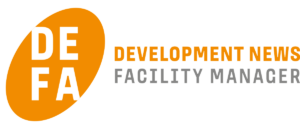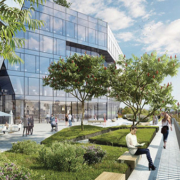 Koncem příštího roku uplyne 30 let od zapsání společnosti CASUA do obchodního rejstříku. Nicméně skutečná spolupráce Olega Hamana a Aleše Poděbrada začala ještě o něco dříve, už 1. července 1990. Takže jubilejní je i rok letošní.
Koncem příštího roku uplyne 30 let od zapsání společnosti CASUA do obchodního rejstříku. Nicméně skutečná spolupráce Olega Hamana a Aleše Poděbrada začala ještě o něco dříve, už 1. července 1990. Takže jubilejní je i rok letošní.
Za léta existence architektonické a projektové kanceláře se firma mnohonásobně rozrostla – z dvoučlenného konsorcia vznikla společnost s ručením omezeným, pro niž nyní pracuje na 70 architektů a stavebních inženýrů.
Měli jste tedy důvod slavit celý rok…
AP: My vlastně slavíme celých 30 let… De facto jsme začali před 1. červencem 1990, kdy jsme oba odešli ze svých pracovišť – Oleg z ateliéru Karla Pragera a já z ateliéru Karla Koutského. Každý z nás si přinesl jednu zakázku, já potřeboval architekta a Oleg potřeboval stavaře. Tak jsme si spolu sedli a začali jsme kreslit a říkali si, že jsme získali svobodu, že se můžeme rozhodovat sami za sebe. Jsme svobodní ve výběru zakázek, klientů a v práci. Počínaje 90. lety jsme začali kreslit něco, co se nám později rozvrstvilo. Práce přicházela (my jsme si ji nehledali) a zároveň se nabalovali lidi. Práce, kterou jsme během těch 30 let dělali, nás opravdu bavila a baví nadále.
Vzpomenete si ještě na ty první zakázky?
OH: Aleš měl udělat první prodejnu BMW v Praze 10, v Průběžné. Když jsem odcházel od Karla Pragera, měl jsem podmínku o odchodu: Zajistit projekt dostavby ZŠ Jitřní v Praze 4. Takže jsme oba potřebovali své zakázky dokončit. Jeden hledal architekta, druhý stavaře. Znali jsme se, tak jsme začali společně kreslit už někdy od března 1990. Název CASUA vznikl už tenkrát.
Co vlastně CASUA znamená?
AP: Nevěděli jsme, co vymyslet, tak nakonec vznikl název jako zkratka z Konsorcium Architektonických Stavebních a Urbanistických Ateliérů. Protože Coca Cola byla lepší než Kofola, udělali jsme z Kasua Casua.
Zní to poněkud cizokrajně…
OH: Věděli jsme, že tam nemůžeme dát tečky, protože by se to nemohlo registrovat jako zkratka, ale ve světě se může registrovat název, ovšem nesmí mít geografický význam, což nebyl ten případ. A navíc nám to znělo hezky i foneticky.
Jakou jste měli společnou vizi do budoucnosti po prvních realizovaných projektech?
AP: Pokusím se to shrnout v kostce ze svého pohledu. My dva se celkem dobře doplňujeme: Zaprvé jsme každý charakterově jiný a zadruhé každý máme svou profesi. Naším cílem bylo dělat hezkou architekturu, dotáhnout to do stavařiny a ideálně být u té stavby. To trvalo prvních pět šest let, do okamžiku, kdy přišel podle mne zlomový bod. V roce 1996 jsme začali s klientem debatovat o zakázce a o rok později jsme uzavřeli smlouvy na projekt v Praze 10, Na Vinici. To nás opravdu posunulo dopředu. Dělali jsme to od stabilizace územního plánu (v územním plánu byla tenkrát bílá místa) až do roku 2004, kdy byla poslední kolaudace. Tento projekt nás vyškolil odborně, v důsledku čehož jsme začali rozšiřovat ateliér. Tenkrát jsme si řekli, že firma nebude mít více než 25 lidí. Když jsme tu zakázku získali, udělali jsme jako architekti a projektanti první chybu ve svém profesním životě, protože jsme se zaměřili na jednoho klienta a neřešili ostatní zakázky. Měli jsme v té chvíli hodně práce, ale vůbec jsme neměli čas myslet na budoucnost – co bude, až to klient dostaví. A tak jsme kolem roku 2000 měli malinko stres a v důsledku toho jsme začali portfolio klientů rozšiřovat tak, abychom vždycky měli nosnou zakázku a k ní nějaké menší. Z osobního pohledu byly pro mne roky 1996–2000 co do růstu firmy zlomové.
Přejděme k současným projektům. Zúčastnili jste se soutěže na zlínskou nemocnici. Co dalšího máte obrazně ještě na stole?
OH: Vyhráli jsme ve Zlíně jako člen sdružení čtyř subjektů veřejnou obchodní soutěž na novou krajskou nemocnici. Na tak velkých zakázkách je třeba vždy nějakým způsobem kooperovat. My jsme v tomto případě byli garantem BIM struktury, koordinace projektu a následně jsme garantovali asi polovinu objektů, které tam byly. Víceméně jsme si prošli všechna odvolání, potvrzení úřadu pro hospodářskou soutěž. Situace je taková, že jsme vyhráli – na což jsme hrdí, ale změnila se politická situace a čekáme na podpis smlouvy o dílo. Stavět špitál na zelené louce, s tím se člověk jen tak nepotká. Absurdní je, že při současné epidemii chybějí ve Zlíně lůžka a pacienty s covidem vozí do Brna. Takže to, co se děje, je pouze politikaření…
V čem jste byli v soutěži lepší než konkurence?
AP: V zadání projektu nemocnice bylo řečeno, že má být užit BIM. Naší výhodou je, že už někdy v roce 2004, aniž jsme tušili, o co přesně jde, jsme měli ve firmě jednoho vizionáře IT, který nás upozornil, že existuje software, který umí projektovat ve 3D. A my jsme si tenkrát koupili 27 licencí. Začali jsme v tom kreslit a teď po 16 letech sklízíme plody práce, kdy se snoubí architektura s technikou a informacemi v modelu. Jsou to zakázky, které se narodily díky tomu, že jsme začali tímto způsobem pracovat. Proto můžeme dělat zakázky jako Zlínskou nemocnici, nebo projekt Bořislavka. Pracujeme na něm společně s ateliérem Aulík Fišer architekti. Jako projektanti projektujeme pro KKCG zakázku Bořislavka v BIM.
Vraťme se k otázce zaměření ateliéru…
AP: Vznikli jsme klasicky jako architekt a stavař – a jak jsme se postupně rozrůstali, je nás dnes v ateliéru okolo 70. Máme určitý počet architektů a určitý počet stavebních inženýrů. Všichni kreslí na počítačích s plnými licencemi. Architekti vymýšlejí projekty, my je kreslíme. Zároveň přijímáme i servisní zakázky, to znamená, že pracujeme pro klienty i dodavatelské firmy, které mají své architekty.
Které projekty jste realizovali v poslední době?
OH: Letos se dokončovala Waltrovka sever, obytný celek včetně rodinných domů. Zkolaudoval se bytový projekt Karlínské dvory II, což je zajímavý projekt mezi ulicemi Křižíkovou a Sokolovskou, a jeden projekt ve Stodůlkách. Změnil vlastníka a celý jsme ho překreslili. Zúčastnili jsme se letos relativně hodně soutěží a při 70 lidech v ateliéru máme i mnoho menších zakázek, přičemž některé jsou úspěšné a některé ne. Což může nastat i tehdy, že developer není úspěšný. Např. jsme nakreslili přestavbu a transformaci objektu věznice v Mladé Boleslavi na nové centrum s výškovou dominantou. Projekt prostě leží, ale ne kvůli nám. Takže někdy se objeví i frustrace, že to zrovna nejde, ale to má každý. Musíme mít sílu jít dál a být schopni unést tyto dílčí ztráty, které jsou na cestě dopředu.
Co vás čeká v krátkodobém horizontu?
AP: Já bych vyšel z letošního roku. Protože to, co se stalo začátkem roku, únor–březen–duben kvůli covidu, zatřáslo s projekty. Zpozdily se, někteří velcí developeři dokonce práce pozastavili a až na jednoho je zase za několik měsíců spustili.
Jaký typ projektů to nejvíce ovlivnilo?
AP: Byly to jak rezidenční projekty, tak i jeden administrativní, které se spustily letos v září. Vedle toho se zpracovávaly ostatní nasmlouvané zakázky, takže letošní rok pro nás vypadá lépe než minulý. Rosteme pomalu nahoru. A plán na příští rok? Ten si vždycky děláme dopředu a vycházíme ze soutěží, které jsme vyhráli, či zakázek dlouhodobě nasmlouvaných s klienty. Nebo to jsou věci, které jsou domluvené, ale ještě nejsou pod smlouvou. Zatím tedy výhled na příští rok vypadá pozitivně ať už v našich autorských projektech, tak v servisní činnosti. Doufáme, že se nám podaří uspět v některé velké soutěži, v nichž figurujeme v posledních kolech. My jsme v této chvíli opatrní optimisté.
Budete se soustředit hlavně na rezidenční projekty?
OH: Bytů je obecně nedostatek. Mimo velké soubory je tu spousta drobnějších věcí, kdy se dostavuje struktura města v prolukách, některé objekty se bourají, nové se stavějí, to vždy bylo a bude. Otázkou zůstává, jak to bude s kvalitou bydlení dál. Spousta developerů si dává zpracovávat analýzy a pak se teprve rozhoduje. Podle mne se nemusíme obávat, že bychom práci v rezidenčních projektech neměli, když se nestane nic zásadního.
Projekty nemáte jen v Praze…
OH: Zlín je toho důkazem. Nějaké drobnosti máme mimo Prahu a na Slovensku, ale zatím žádný větší projekt typu jako bylo v minulosti bratislavské letiště.
Atelier CASUA figuruje v různých nadacích a profesních organizacích, často jste aktivními účastníky veletrhů, a to nejen v ČR…
OH: V roce 2007 jsme dostali nabídku se stát členem sítě Equator Europea Architects, kde bylo asi 13 ateliérů ze 13 zemí. Nabídku jsme přijali. Nám ta spolupráce dávala smysl; jedním z hlavních momentů je, že se společně účast-
níme veletrhů, např. MIPIM v Cannes, se stánkem. Jsme vlastně jediné české studio, které má svůj – byť malý – ale stánek. Pochopitelně krize v roce 2008 semlela firmy ze západní Evropy, takže některé ateliéry už neexistují nebo vystoupily. Equator se v důsledku toho trochu zmenšil. Dnes v něm kralují hlavně skandinávské země a my. Takže kupodivu všechny země, které hrají dobře hokej – s ústředím ve Stockholmu. Zajímavé je, že švédský Equator Stockholm je členem Swedish Green Building Council, tedy uznávané vedoucí instituce ve světě trvalé udržitelnosti – a my máme možnost od nich čerpat ty nejnovější poznatky. To, že tady o takové poznatky není mezi developery až takový zájem, nebo někdy jen tak na oko, to je věc druhá. Ale my díky tomu máme přístup k velice cenným informacím. Jsme také členy České rady pro šetrné budovy a Česko-izraelské smíšené obchodní komory. Když jsme se hledali možnost, jak přispívat na dobročinné účely, vybrali jsme si věc, která nás zaujala: Cenu Arnošta Lustiga za odvahu, statečnost, lidskost a spravedlnost. Podmínkou podpory této ceny byl právě vstup do Česko-izraelské smíšené obchodní komory, kde jsme zjistili, že velice dobře funguje a mezi členy je mnoho šikovných lidí a je pro nás zajímavá i obchodně. Takže se to krásně propojilo.
Arnošt Wagner / Foto: archiv Casua





 By the end of next year, it will be 30 years since CASUA was entered in the Register of Companies. Nevertheless, the real co-operation between Oleg Haman and Aleš Poděbrad commenced a bit earlier, on 1st July 1990. That means that this year is also a jubilee one.
By the end of next year, it will be 30 years since CASUA was entered in the Register of Companies. Nevertheless, the real co-operation between Oleg Haman and Aleš Poděbrad commenced a bit earlier, on 1st July 1990. That means that this year is also a jubilee one.

 We spoke with Viktor Peška, Chief Commercial Officer at Crestyl, not only about how a successful developer is doing in these turbulent times but how much the real estate market has changed in 2020.
We spoke with Viktor Peška, Chief Commercial Officer at Crestyl, not only about how a successful developer is doing in these turbulent times but how much the real estate market has changed in 2020.